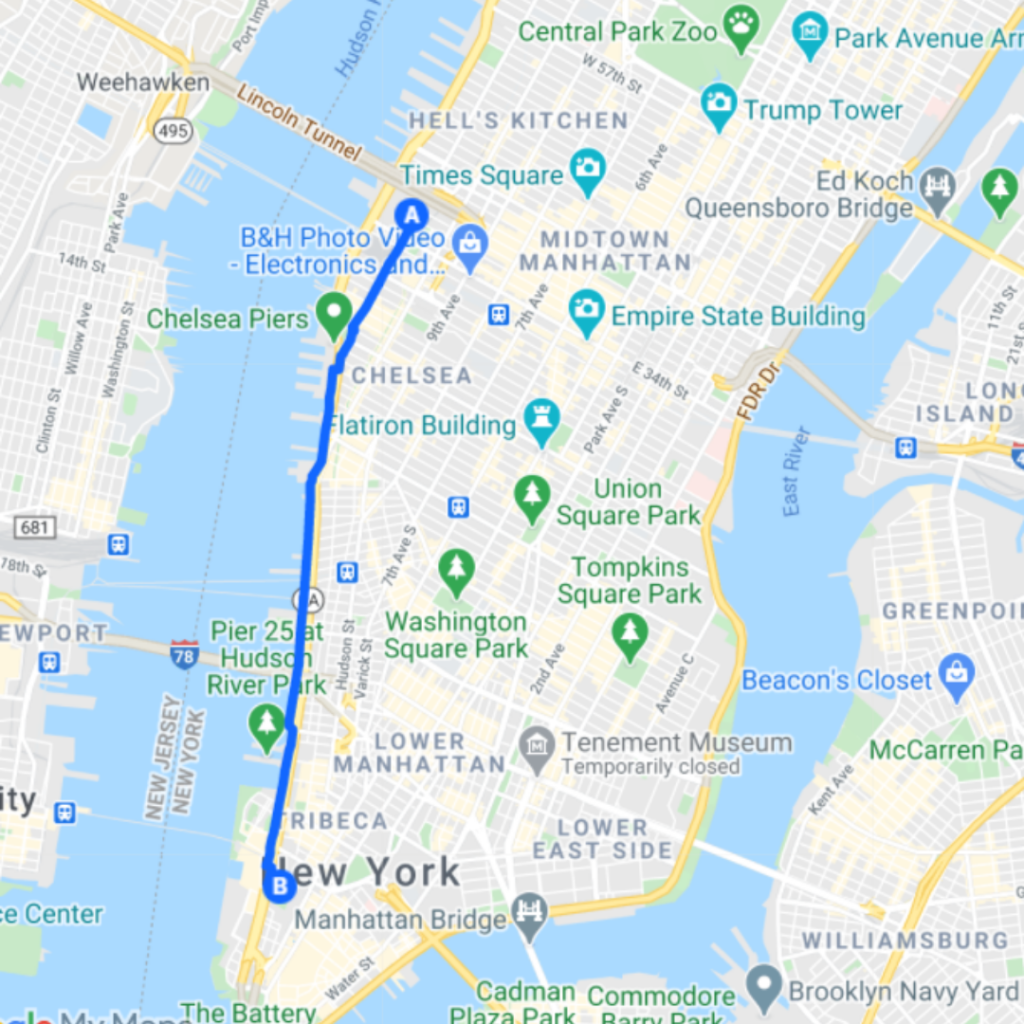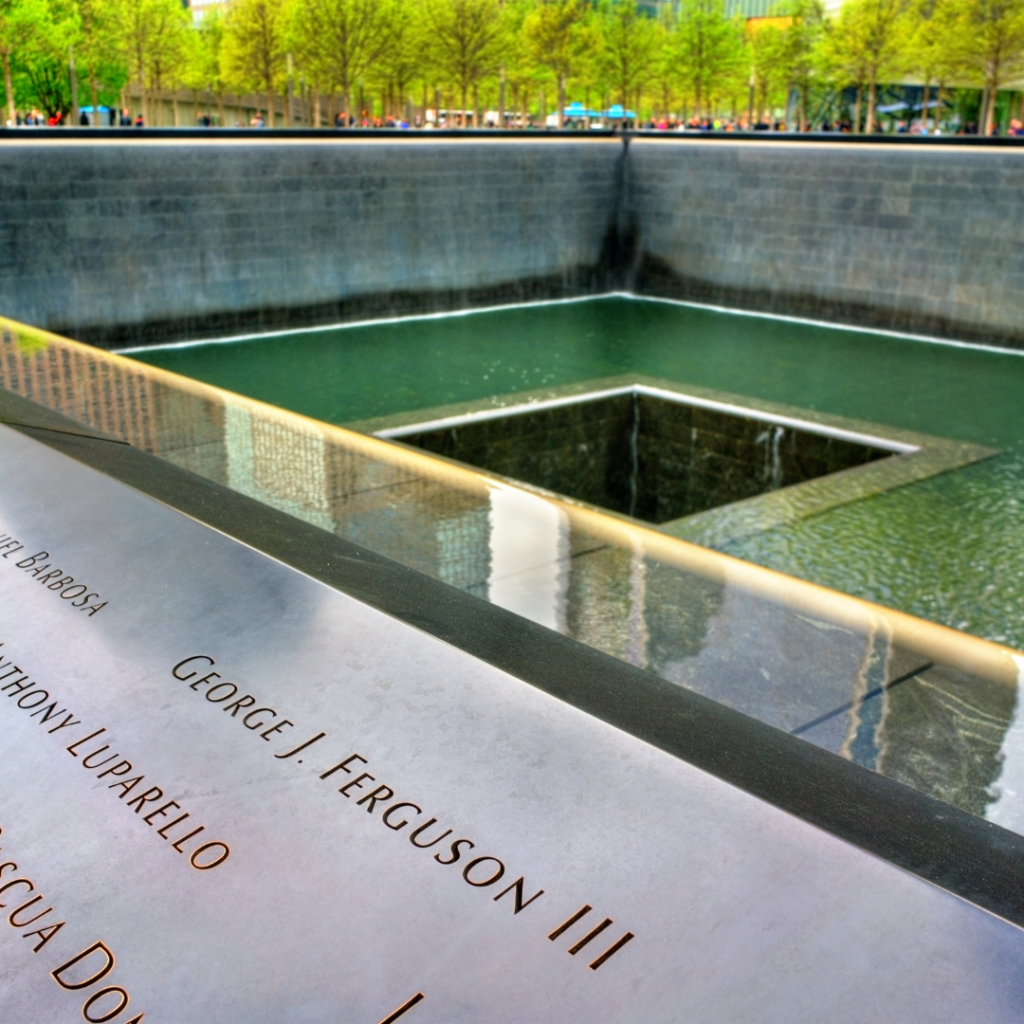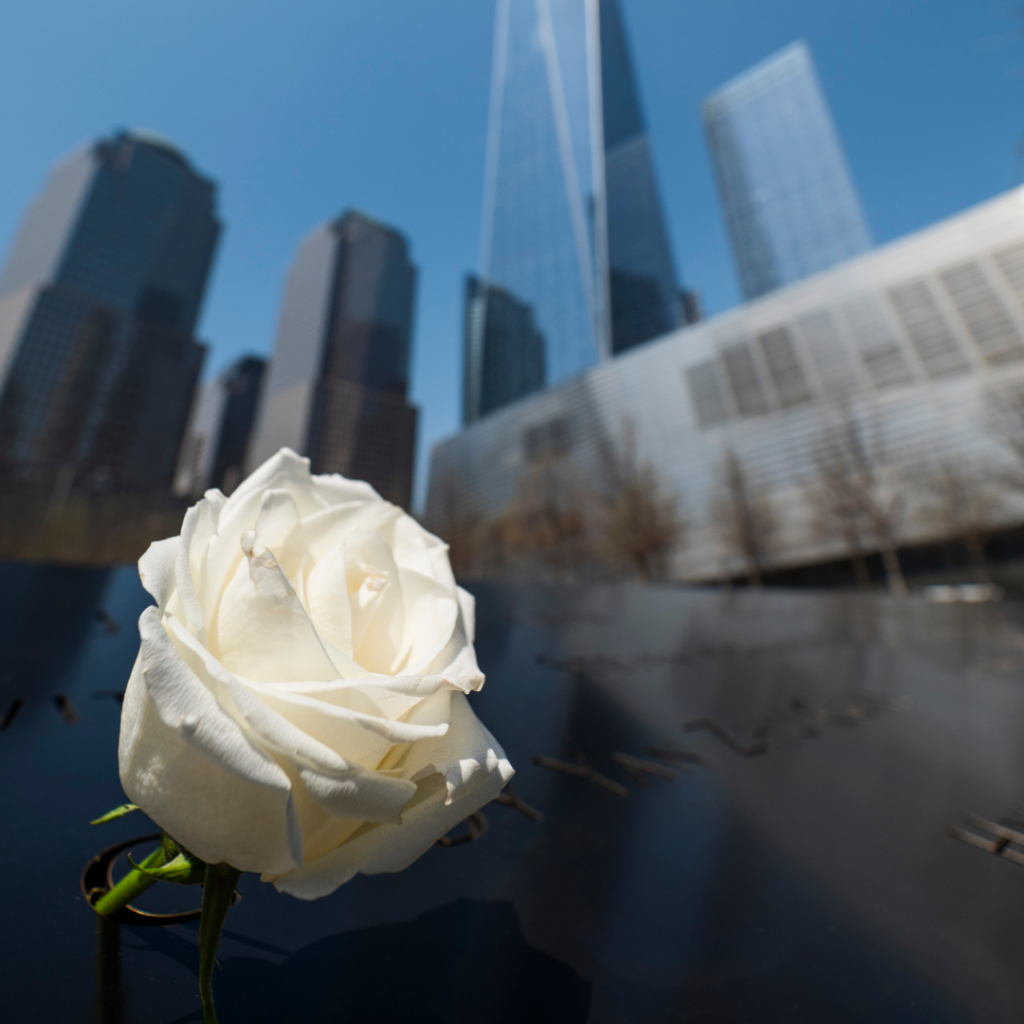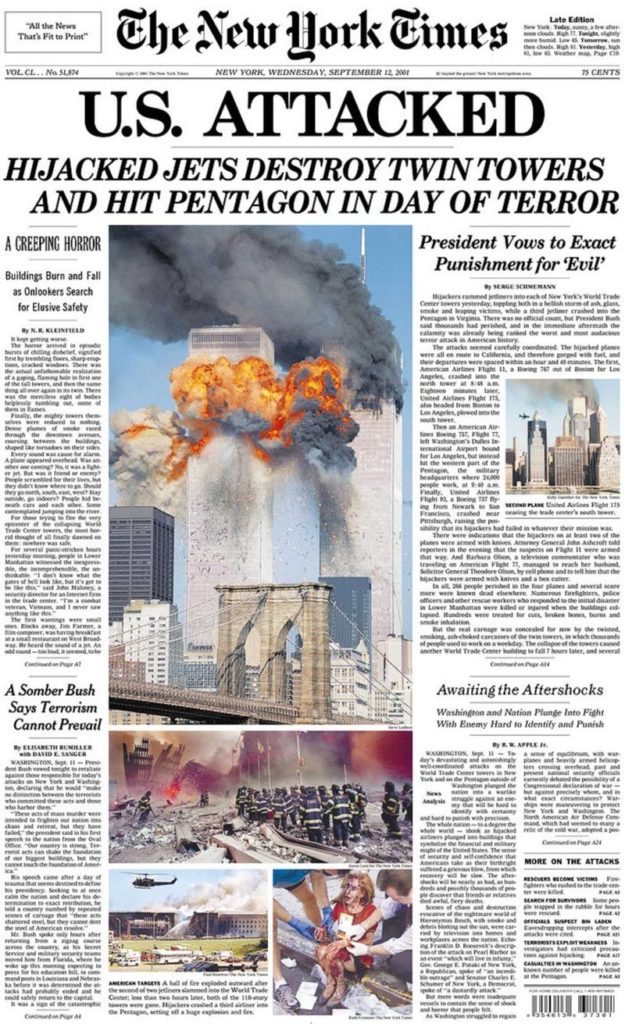We may earn money or products from the companies mentioned in this post.
It seems that every generation has that one moment in time where you never forget what you were doing when you heard the news.
For us, that was September 11, 2001.
A vital part of modern day American history, this moment in time will forever be marked in our lives.
As we just recently passed the 19th anniversary of this day (how has it been that long?), Peter and I had an open discussion about that day.
For me, it was my third day of high school when someone came into my English class making what we thought was a joke. “A plane flew into the World Trade Center.”
I still remember him saying it and not believing it. A few moments later, our beloved principal came over the intercom and confirmed the news.
Sitting back, 19 years later, I still think about how I almost missed my chance of getting to experience such a fantastic piece of New York City architecture.
Just months before the attacks I debated about going on a field trip with my finance class that would take us to the top of the towers. That trip gave me something at the time, I never thought would disappear.
Fast forward to 16 years after the attacks and I found myself back in New York City.
Having lived just a few hours from the city, I would make the trip every so often for a broadway show or convention, but I never allowed myself to experience the mass difference it was from that first time I was in the city.
In all honesty, I just never allowed myself to grieve.
The grief isn’t for myself, but for the future, for the ones lost, for everything we once knew to be insecure all of a sudden. The grief was for the bubble we lived in.
This time, I found courage to absorb the grief as I walked from the Javits Center (yes walked) to the memorial (in actuality it is about 3 miles).
I’m not sure I knew what to expect when arriving at the 9/11 Memorial & Museum.
Would it be like historical parks or battlefields? Would it be like a war memorial or maybe a church?
I didn’t do any research before making the decision to visit, I literally just started walking.
Before my arrival, I could feel the atmosphere change. The air was still, the city noise abundantly quieter.
Just down the street, I passed as children played in a schoolyard, laughing, screaming, just being kids. To a sudden, heartfelt solace in the air.
The trees that lined the West St, where new, unhindered by the burden of the city. It was the entrance into a new beginning.

As I crossed the street I could hear the low mumbles of the crowd and the soft roar of the waterfalls. It was like the world was eternally crying as I approached the waterfall pools.
The release of grief and anger, washed over me as I read the names. (If you would like to know the names of the victims click here, you can see where they are placed on the waterfall pool).
Running my fingers over them, wondering so many unanswered questions.

As I walked around the North and South waterfall pools, I noticed small clusters of tourists gathering.
I’m not sure if the memorial is part of a guided tour program or if these where high school field trips. But as I found a place to sit and reflect on my own emotions, I started to see a major lack of respect for not only those of us at the 9/11 Memorial but for the memorial itself.
Similar to the selfies taken in places like Auschwitz, the disrespect was abundantly clear by those around me that day.
Note: there are no signs about taking selfies at the memorial, however, there are signs about volume and respect for those around you.
So in retrospect, I can’t technically be mad at these individuals for taking selfies because there were no instructions.
But in all honesty, it would be nice for just some general courtesy that people would understand there are certain locations that selfies should be a hard no, out of respect.
What can you expect when visiting 9/11 Memorial?
When visiting the 9/11 Memorial in New York City there were a few things I observed beyond my frustration of the crowds.
Family of Those Lost, Visit Daily
Since my first visit to the memorial in 2017, I’ve had the privilege of passing through the park a few times on many different trips. Each time I’ve been, there has been at least one family member or friend of someone who lost their life paying their respect as well.
You might not always realize that there are family members there, but remember, many of those who lost their lives lived within close proximity of the towers. This means that a wife, father, sister, grandparent, best-friend could all be passing by on their way to work or during lunch just to be with that person they lost that day.
If you do happen to realize or even meet someone who lost a loved one, give them space. Their grief is exponential. they don’t always want to talk, although some want too.
This is why there are signs requesting quiet and peace around the waterfall pools. It’s a place of mourning even if you can’t see it.
Roses Have Significance
When I first visited the memorial, I was deeply inquisitive of what the different flowers meant.
While yes family members visit daily, could they be placing that many flowers and flags every single day?
Upon my return, I learned that the roses placed throughout the memorial have significance.
White Roses are placed every day on the names of those who have birthdays that day. The staff of the memorial takes the time before the park opens to give the donated white rose based on the book of names of all who were lost on September 11, 2001.
Yellow Roses are placed on the names of those who served in the US military in celebration of veteran’s day.

Memorabilia and Tributes of All Kinds
The memorial has rules around what you can and can’t do or leave at the waterfall pools. But you might find some pretty awesome personal memorabilia from family members or friends.
Some things include teddy bears, food, red roses or even flags.
All should be maintained with honor as if you would enter a cemetery or war monument.
What can you see at the 9/11 Memorial?
Besides the two main water features of the North and South Waterfall pools, you will be able to experience over 400 trees planted to represent the “rebirth of the World Trade Center site” (Quote by Memorial President Joe Daniels).
Of the 400 trees there is one specific tree that you will want to encounter. It might be the only survivor of 9/11 you will ever personally get to meet. That is the Survivor Tree.
The Survivor Tree
The story behind the survivor tree is that it was found in the rubble of the fallen towers. The staff of parks and rec of NYC removed the tree and nurtured it back to life.
The tree was then replanted in 2010 among the other memorial trees.
Today, the tree is surrounded by a small fence to protect it from the public, where it is flourishing and providing new seeds every year.
In fact, the 9/11 Memorial has a program where they provide seeds to certain cities and locations that were hit by terrorism and crime every year.
Without the many brave men, women and K9s the tree and many others would not have survived the terrorist attacks of 9/11. Part of the memorial is not just to memorialize those lost on that day, but also those who responded.
The 9/11 Memorial Glade
The glade was built to help memorialize the sacrifices the first responders took into the unknown territory of the 9/11 attacks.
Many of the rescuers suffer today from health problems relating to the attacks, causing more unforeseen sacrifice on them and their families.
The glade holds metal from the fallen World Trade Center in the 6 large stones that flank the walkway. A representation of what was, what was given, and what will continue to rise.
You can learn more about the glades dedication in 2019 here.
Are the 9/11 Memorial and Museum the same thing?
At first I thought they were the same thing! But they are actually two separate portions of the World Trade Center Memorial.
The memorial is free to anyone and is open between 10AM – 5PM EST every day.
The museum starts at $26 for adults to enter and is open between 10AM – 5PM EST every day.
What can I expect when entering the 9/11 Museum?
To be honest, there really is no way to truly prepare for the emotional rollercoaster that can potentially hit you upon entering the 9/11 Museum.
The Main Exhibit
In the first part of the main exhibit, you will be able to see artifacts from the World Trade Center as the museum does a great job of walking you through the events of that tragic day.
Here you will see artifacts from victims of the attacks found in the rubble. These can be individuals who worked in the building, rescue workers and even those on the hijacked flights.
In the second part of the main exhibit, you will see artifacts from the 1993 attack on the World Trade Center and many of the known facts of things that lead up to the attack in 2001.
You will learn about the events that lead up to the attacks on 9/11/2001 from the first bombing that occurred in 1993, the differ extremist who carried out both attacks and the steps that are known to have happened by the hijackers up to the day of the attacks.
In the third part of the main exhibit, you will see artifacts from the days, weeks, and months of the rescue and later cleanup of Ground Zero.
You will learn about the rescue teams and their efforts to recover anyone who was still alive after the collapse of the towers along with how they worked to help bring closure to family and friends of those who would not be coming home.
Ultimately the main exhibit, broken down into three sections, provides you with a story of how the world changed due to terrorism


The Memorial Exhibit
This portion of the exhibit hit me pretty hard. Standing next to fire trucks, ambulances, even the remaining pieces of the towers, it became real and not just a piece of history that will be learned in text books for generations to come.
It was tangible, beyond the newspapers, documentaries, and television specials.
This exhibit is what put faces on the memories we all have from that day.
For anyone who watched the attacks on the Twin Towers and on America that day, this location, this exhibit removes those barriers of television and newspapers, it becomes personal.
In this exhibit, you can see pictures and bios about the individuals lost. Their names now had backstories to them and not just another labeling of “victim”. Each wall is decorated from floor to ceiling with images and names of each individual lost on the day of September 1, 2001.
Their ages span from 2.5 years old to 85. Representing over 90 nations, their genders, race, ethnicity, religion, and socioeconomic statues range on many different spectrums.
Here you can take the time to learn about their positions, their careers, their family, their lives all projected from the point of view of the ones left behind.
Currently, the interactive program for this portion of the museum is not available due to health and safety guidelines (September 2020).
Conclusion
Paying tribute to the victims of September 11, 2001 happens every year on the anniversary of the attacks. As time moves forward the memorials become less publicized, smaller more private affairs and generational aging, my fear is that the memories of that day will be lost on the public.
For this, I recommend a visit to the memorial when you are in New York City. Give remembrance of the lives changed, of the purserverance of our country, and the rebuilding of the community the days and months after the evil that hit our country that day.
You Might Also Like

The Portly Passengers provides plus size inclusive travel tips and advice for anyone who is looking to explore the world. From seat sizes on airplanes to exploring museums, restaurants, and nature Melissa & Peter have the experience and stories to help guide you through it.


